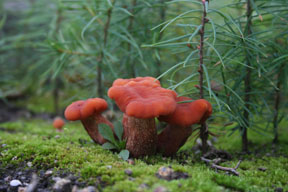Laccaria bicolor
Laccaria bicolor is a species of mushroom belonging to the family Hydnangiaceae. It is notable for its symbiotic relationship with various tree species, acting as a mycorrhizal partner and playing a significant role in forest ecosystems. This mushroom is characterized by its distinctive two-toned coloration, with a typically lilac to purple cap and gills, and a white to pale stalk. Laccaria bicolor is widely studied for its ecological importance and potential applications in forestry and mycoremediation.
Description[edit | edit source]
Laccaria bicolor features a cap that ranges from 2 to 10 cm in diameter, initially convex before flattening out with age, often retaining a slight central depression or umbo. The cap's surface is smooth, with a lilac to purple hue that fades with age or exposure to sunlight. The gills are spaced moderately, adherent to slightly decurrent, and share the cap's distinctive coloration, though they may lighten over time. The stalk measures 4 to 10 cm in height and 0.5 to 1 cm in thickness, more or less equal along its length but sometimes swollen at the base. It is white to pale lilac, becoming hollow with age.
The spores of Laccaria bicolor are broadly ellipsoid, smooth, and possess a distinctive spore print color that ranges from white to pale pink. This species is found in both coniferous and deciduous forests, forming symbiotic mycorrhizal associations with a wide variety of trees, including species of pine, oak, and birch. These relationships are crucial for nutrient exchange between the fungus and its host, facilitating the growth and health of forest ecosystems.
Habitat and Distribution[edit | edit source]
Laccaria bicolor is widely distributed across North America, Europe, and parts of Asia, thriving in both temperate and boreal forests. It prefers moist, well-drained soils rich in organic matter and is commonly found in mixed woodlands, often forming fairy rings. The presence of Laccaria bicolor is an indicator of a healthy mycorrhizal network within a forest, contributing to the biodiversity and productivity of these environments.
Ecological Role[edit | edit source]
The ecological role of Laccaria bicolor is primarily as a mycorrhizal fungus, facilitating the transfer of water, nutrients, and minerals from the soil to its plant partners. This mutualistic relationship enhances plant growth, increases resistance to environmental stressors, and contributes to the overall stability of forest ecosystems. Laccaria bicolor is also involved in soil formation and maintenance processes, helping to bind soil particles together and improve soil structure.
Research and Applications[edit | edit source]
Research on Laccaria bicolor has focused on its potential applications in forestry, such as in the reforestation of degraded lands and the enhancement of tree growth in commercial forests. Its ability to form mycorrhizal associations with a wide range of tree species makes it a valuable tool in forest management and conservation efforts. Additionally, studies on the genetic and molecular basis of the symbiotic relationship between Laccaria bicolor and its host plants are providing insights into the mechanisms of mycorrhization, with potential applications in improving the efficiency of nutrient uptake in crops.
See Also[edit | edit source]
Search WikiMD
Ad.Tired of being Overweight? Try W8MD's NYC physician weight loss.
Semaglutide (Ozempic / Wegovy and Tirzepatide (Mounjaro / Zepbound) available. Call 718 946 5500.
Advertise on WikiMD
|
WikiMD's Wellness Encyclopedia |
| Let Food Be Thy Medicine Medicine Thy Food - Hippocrates |
Translate this page: - East Asian
中文,
日本,
한국어,
South Asian
हिन्दी,
தமிழ்,
తెలుగు,
Urdu,
ಕನ್ನಡ,
Southeast Asian
Indonesian,
Vietnamese,
Thai,
မြန်မာဘာသာ,
বাংলা
European
español,
Deutsch,
français,
Greek,
português do Brasil,
polski,
română,
русский,
Nederlands,
norsk,
svenska,
suomi,
Italian
Middle Eastern & African
عربى,
Turkish,
Persian,
Hebrew,
Afrikaans,
isiZulu,
Kiswahili,
Other
Bulgarian,
Hungarian,
Czech,
Swedish,
മലയാളം,
मराठी,
ਪੰਜਾਬੀ,
ગુજરાતી,
Portuguese,
Ukrainian
Medical Disclaimer: WikiMD is not a substitute for professional medical advice. The information on WikiMD is provided as an information resource only, may be incorrect, outdated or misleading, and is not to be used or relied on for any diagnostic or treatment purposes. Please consult your health care provider before making any healthcare decisions or for guidance about a specific medical condition. WikiMD expressly disclaims responsibility, and shall have no liability, for any damages, loss, injury, or liability whatsoever suffered as a result of your reliance on the information contained in this site. By visiting this site you agree to the foregoing terms and conditions, which may from time to time be changed or supplemented by WikiMD. If you do not agree to the foregoing terms and conditions, you should not enter or use this site. See full disclaimer.
Credits:Most images are courtesy of Wikimedia commons, and templates, categories Wikipedia, licensed under CC BY SA or similar.
Contributors: Prab R. Tumpati, MD

